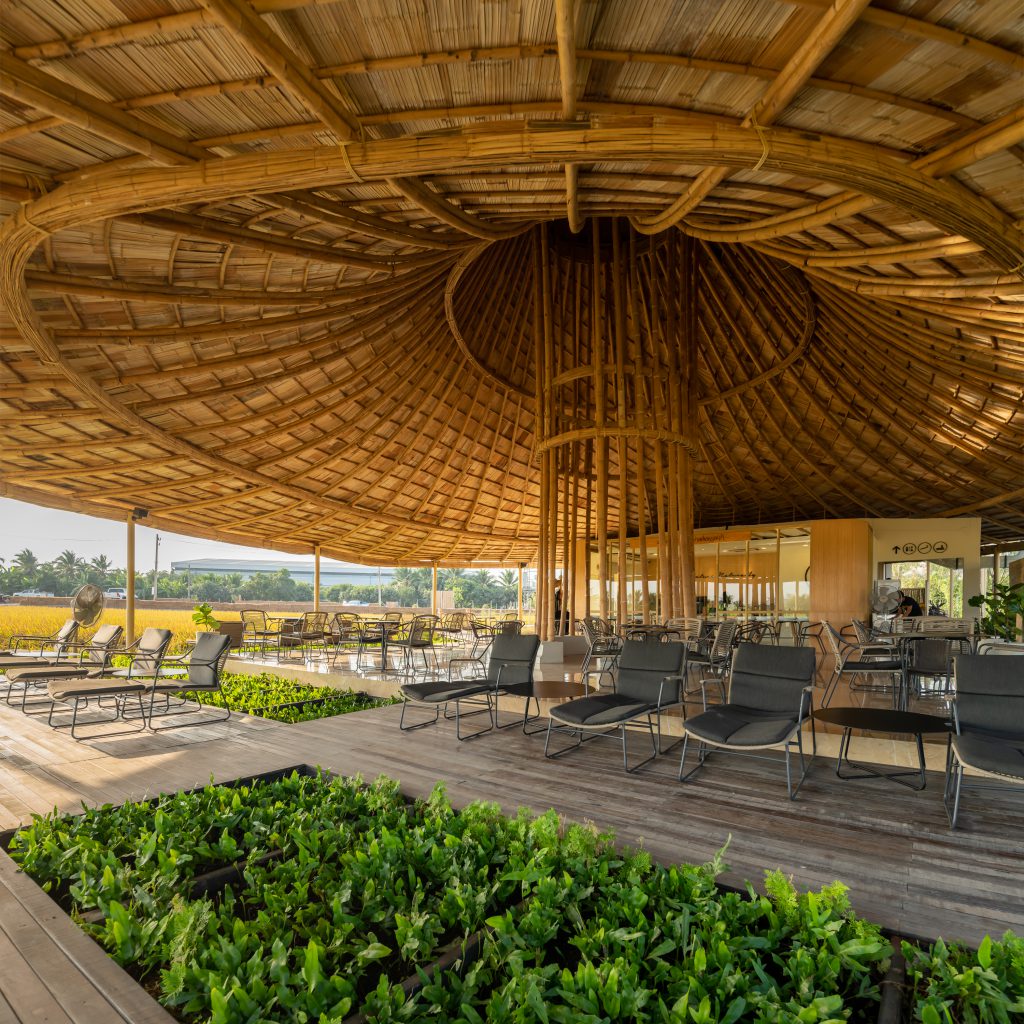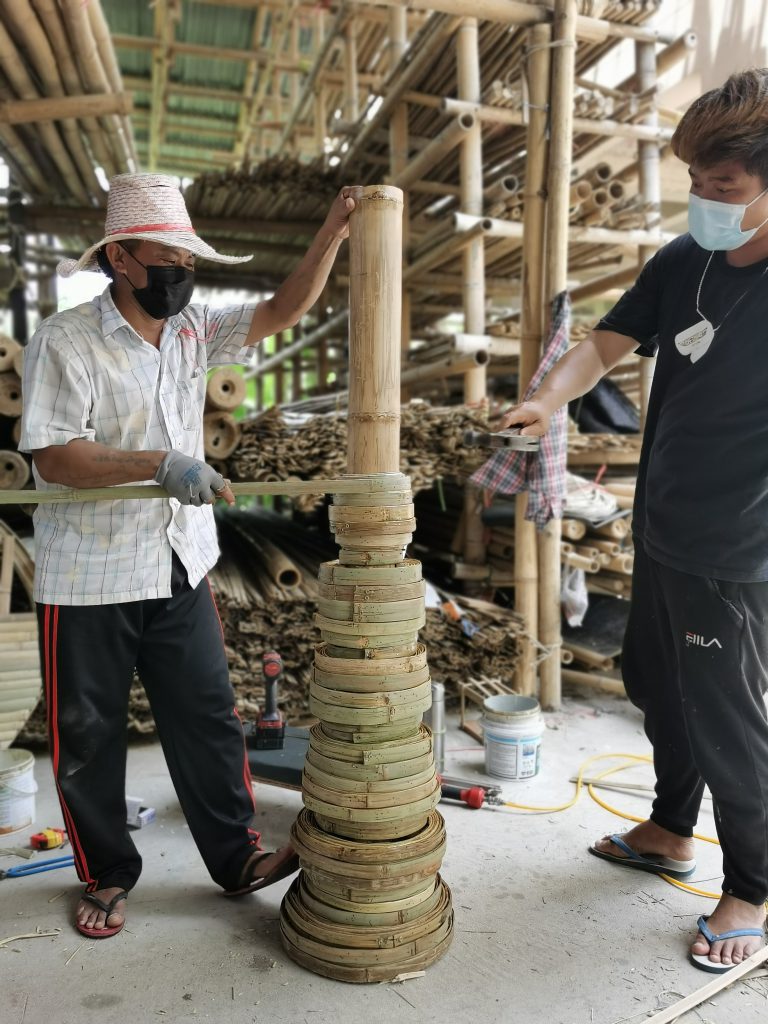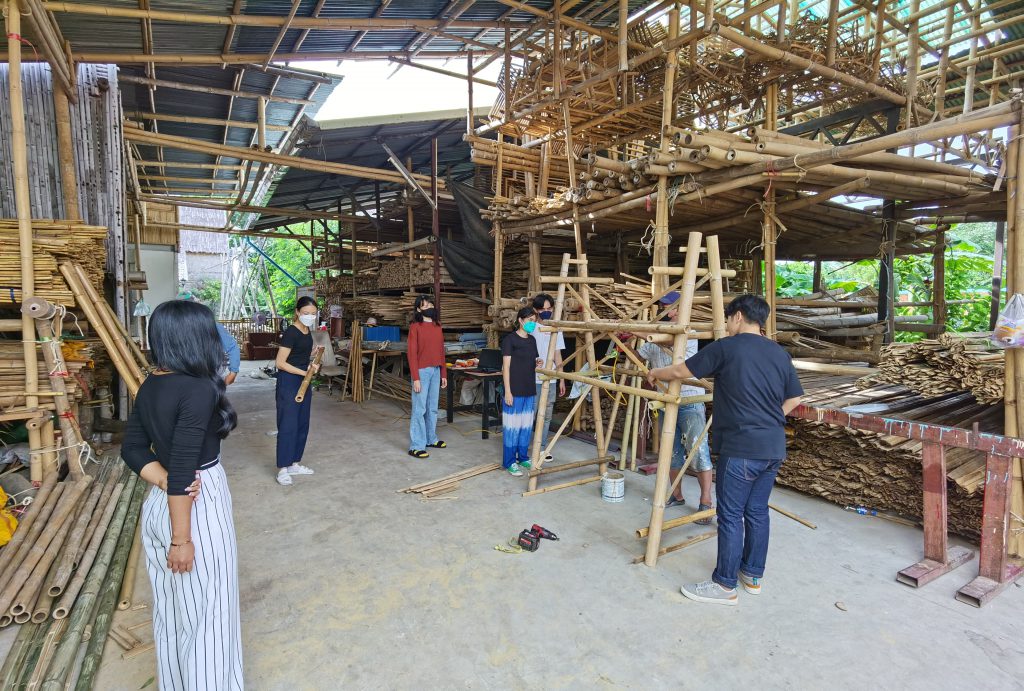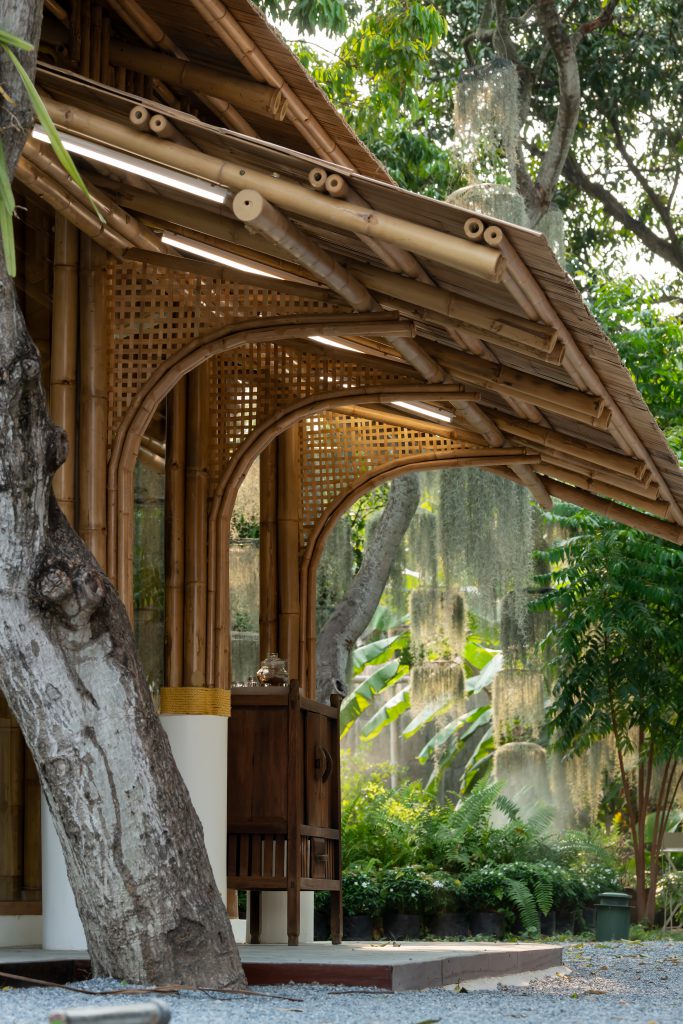Thor Kaichon is an architecture firm known for its expertise in bamboo architecture. The name Thor Kaichon comes from the first letter of the studio founder’s name, Thanapat ‘Tup’ Boonsanan, (Thor stands for Thanapat) while Kaichon is a Thai word for fighting cock, which Thanapat is personally passionate about. He takes inspiration from how Thai businesses in the past often used the first letter of the owner’s name followed by a simple word with straightforward imagery to catch people’s attention such as the elephant glue, the lion flour, the frog battery, or the monkey balm.
Text: Nuttawadee Suttanan
Photo Courtesy of Thor Kaichon

“ธ.ไก่ชน” ตัวตนที่สะท้อนผ่านการบริหารงาน
ธ.ไก่ชน คือบริษัทสถาปนิกที่มีความโดดเด่นจากการนำ “ไม้ไผ่” มาเป็นส่วนหนึ่งของงานสถาปัตยกรรม ชื่อ “ธ.ไก่ชน”คือการเอาอักษรตัวแรกของชื่อจริงของ ตั๊บ ธนพัฒน์ บุญสนาน ผู้ก่อตั้งและความชอบส่วนตัวอย่างไก่ชนมารวมกัน โดยได้แนวคิดจากการตั้งชื่อธุรกิจแบบไทยๆ ที่มักจะมีชื่อเจ้าของก่อน แล้วตามด้วยคำที่คนมักจะจำได้ เช่นชื่อต่างๆ เหมือนอย่างตราช้าง ตราสิงห์ ตรากบ ตราลิงถือลูกท้อ และวันนี้เรามีโอกาสได้นั่งคุยกับตั๊บถึงรูปแบบการบริหารแบบ ธ.ไก่ชน ที่น่าสนใจไม่แพ้บริษัทสถาปนิกไหน
“ธ.ไก่ชน เกิดจากการไม่หยุดแม้แต่วันเดียว”
ตั๊บจบการศึกษาระดับปริญญาตรีจากคณะสถาปัตยกรรมศาสตร์ มหาวิทยาลัยศิลปากร หลังเรียนจบเขาเริ่มต้นชีวิตการทำงานที่บริษัทสถาปนิกย่านห้วยขวางได้สองปี ก่อนจะพบว่าตัวเองไม่ชอบการเดินทางและทำงานในเมือง ตั๊บรู้สึกสนใจการทำงานเกี่ยวกับวัสดุธรรมชาติและ “ไม้ไผ่” ก็เป็นวัสดุตัวเลือกที่เขาให้ความสนใจ เขาจึงตัดสินใจเรียนต่อที่สถาบันเทคโนโลยีพระจอมเกล้าเจ้าคุณทหารลาดกระบังอยู่หนึ่งเทอม ก่อนจะแบกเป้ไปเข้าร่วมเวิร์คชอปเกี่ยวกับสถาปัตยกรรมไม้ไผ่ที่เชียงใหม่กับ Olav Bruin จาก 24H Architecture สถาปนิกจากเนเธอแลนด์ผู้เชี่ยวชาญเรื่องไม้ไผ่ หลังการเข้าร่วมเวิร์คชอป เขาจึงตัดสินใจที่จะศึกษาเรื่องไม้ไผ่อย่างจริงจัง ด้วยการขอไปเรียนรู้วิธีการทํางานไม้ไผ่กับ Chiangmai Life Construction (CLC) โดยอาศัยการสังเกต พูดคุย และคลุกคลีกับช่างกว่า 3 เดือน ตั้งแต่วิธีการก่อสร้าง การออกแบบและการดูแลไม้ไผ่ การทำงานไม้ไผ่งานแรกในชีวิตของเขาคือการออกแบบอาคารต้อนรับ โครงการ Cool Downs Resort อำเภอแม่ริม จังหวัดเชียงใหม่ และเป็นที่มาของการจดทะเบียนบริษัท ธ.ไก่ชน เป็นจุดเริ่มต้นที่ทำให้เขาทำงานเกี่ยวกับไม้ไผ่ และหลังจากนั้นเขาก็ไม่เคยเลือกรับงานที่ไม่ใช้ไม้ไผ่เลยจนทุกวันนี้ สิ่งที่ทำให้ ตั๊บ และ ธ.ไก่ชน ผ่านมาได้จนทุกวันนี้ คือการทำงานอย่างหนักในช่วงเริ่มต้นนั่นเอง
การทำงานรับเหมาที่มีโรงงานที่กรุงเทพและทำงานออกแบบที่เชียงใหม่ไปด้วย เหมือนจะเป็นไปไม่ได้ แต่ผมคิดว่ามันเกิดจากการที่เราไม่หยุดแม้แต่วันเดียว วันที่หยุดคือไม่ไหวจริงๆ วันที่เหลือคือทำงาน คือไปศึกษางานไม้ไผ่อย่างเดียวเป้าหมายของเราตอนนั้นคือเรารับงานมาแล้ว เราก็อยากจะสร้างให้เสร็จ มันมีแค่นั้น ทำไงก็ได้ สร้างให้เสร็จ
“เราไม่ใช่จุดศูนย์กลางของโลกนี้อีกต่อไป”
ในปีแรกของ ธ.ไก่ชน ทุกหน้าที่ในบริษัท ยกเว้นส่วนของงานช่าง ส่วนของการดูแลไม้ไผ่ มีพนักงานเพียงคนเดียวชื่อว่า “ธนพัฒน์” โดยบริษัท ธ.ไก่ชน ประกอบด้วยการทำงาน 3 ส่วน คือ 1) ผู้ผลิตและจัดจำหน่ายไม้ไผ่ 2) ผู้รับเหมา 3) สถาปนิก ในช่วงแรกของการทำบริษัท การทำงานจะให้น้ำหนักในส่วนการผลิตไม้มากที่สุด โดยมีเป้าหมายคือการสร้างโรงงานผลิตไม้ไผ่ จากการทำทุกอย่างคนเดียวและมีพนักงานคนแรกในปีที่สี่ ปัจจุบัน ธ.ไก่ชนก้าวเข้าสู่ปีที่แปด พร้อมกับพนักงาน 7 คน เป็นพนักงานธุรการ 1 คน และสถาปนิก 6 คน ซึ่งในส่วนของสถาปนิก นอกจากการออกแบบ ธ.ไก่ชน ก็มีตำแหน่งพิเศษที่จะคอยช่วยดูเรื่องการก่อสร้างหน้างานโดยเฉพาะอีกด้วย โดยตั๊บยังคงทำหน้าที่เป็นผู้บริหารสูงสุดและดูแลทั้งหมดอยู่เช่นเดิม การบริหารจัดการบริษัทจากการทำทุกอย่างคนเดียวสู่การมีพนักงานถึง 7 คน ทำให้มุมมองหลายอย่างของเขาเปลี่ยนไปสิ่งสำคัญที่เขาเรียนรู้คือเขาไม่ใช่จุดศูนย์กลางของโลกนี้อีกต่อไป และงานออกแบบไม่ได้ขึ้นอยู่กับเขาเพียงอย่างเดียว แต่คืองานออกแบบของสถาปนิกใน ธ.ไก่ชน
“หลังๆ พอได้ทำงานกับน้อง ๆ เขาก็จะมีอะไรใหม่ๆ มีความคิดใหม่ๆ คือดีใจที่ได้เห็นอาคารมันหน้าตาแปลกไปแบบที่ไม่คิดว่าจะได้เจอ ก็มีความสุข แล้วเราก็ใช้สมองน้อยลง ก็ไปคิดเรื่องอื่นมากขึ้น คือเหมือนได้หายใจลึกๆ หลายรอบเหมือนหายใจได้ทั่วท้อง เราสามารถปล่อยพลังเหมือนเมื่อก่อนออกไปได้”
การได้รับฟังผู้อื่นและการได้มีคนมาทำงานด้วยกัน ทำให้เขาได้ใช้เวลาในการคิดงานออกแบบและเรื่องอื่นๆ อย่างเต็มที่มากขึ้นและสร้างผลงานที่ดีขึ้นกว่าเดิม ไม่ใช่แค่ในส่วนของสถาปนิก แต่การมีพนักงานในส่วนของงานธุรการและเอกสารก็ช่วยให้งานออกแบบดีขึ้นเช่นกัน เพราะการทำงานธุรการเองทั้งหมดในช่วงแรกเป็นสิ่งที่สร้างความเครียดและทำให้งานออกแบบทำได้ไม่ดี
“ถ้าชอบ เขาก็จะรู้สึกว่าอยากเป็นส่วนหนึ่งของเรา”
หัวใจของการทำงานที่ ธ.ไก่ชน คือความใส่ใจทุกคนในบริษัท ทั้งการทำงานในสิ่งแวดล้อมที่ดี บรรยากาศในการทำงานที่ดี และความรู้สึกเป็นส่วนหนึ่งของบริษัท ธ.ไก่ชน ใช้ระบบการทำงานที่บ้านมาตั้งแต่เริ่มมีพนักงานคนแรก โดยไม่ได้กำหนดให้พนักงานต้องเข้ามาทำงานที่บริษัทในช่วงปีที่แปด ธ.ไก่ชน เริ่มเน้นในส่วนงานออกแบบมายิ่งขึ้น ตั๊บตัดสินใจที่เอาเงินเก็บทั้งหมดที่มีมาทำอาคารสำนักงานเพราะเขาเห็นว่าถ้าพนักงานไม่ได้ทำงานในสถาปัตยกรรมไม้ไผ่ที่มีคุณภาพ ก็จะไม่สามารถผลิตสถาปัตยกรรมไม้ไผ่ที่มีคุณภาพออกมาได้ สิ่งหนึ่งที่เห็นได้ชัดคือถึงระบบจะยังคงเป็นการทำงานที่บ้านเช่นเดิม แต่พนักงานกลับชอบเข้ามาทำงานที่บริษัทมากขึ้น และคุณสมบัติแรกที่เขามองว่าพนักงานของ ธ.ไก่ชน ต้องมี คือ “รัก สนใจ และมีความกระหายอยากจะทำงาน”
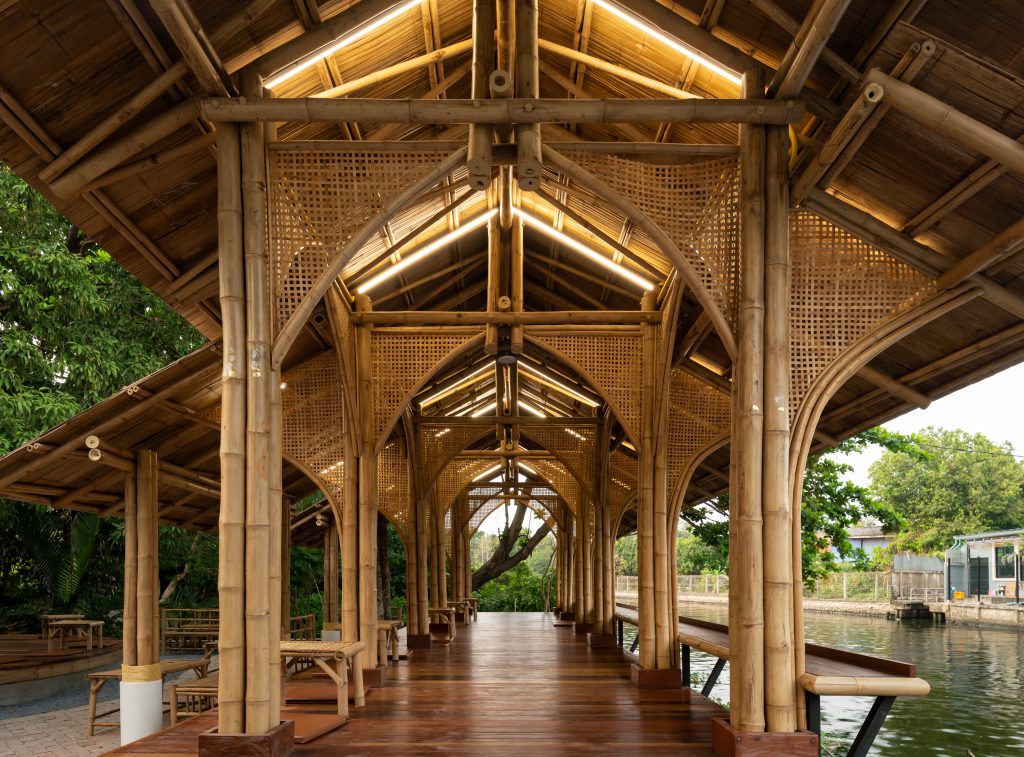
เราเลือกคนที่ชื่นชอบในการทำงานขององค์กร คือต้องชอบเราก่อน ชอบในวิธีการทำงานของเราก่อน ถ้าชอบเขาก็จะรู้สึกว่าอยากเป็นส่วนหนึ่งของเรา ผมอาจจะเลือกจากเด็กธรรมดาคนหนึ่งแต่ว่ามีใจรักในองค์กรมาก เพราะอย่างเช่นการมาทำงาน เราไม่ได้อยู่ในที่ที่เลิกงานแล้วไปเที่ยวได้ทุกที่ ต้องยอมรับว่ามันมีความลำบากนิดนึง ถ้าไม่มีใจรักที่จะอยู่ที่นี่ ไม่มีใจรักธรรมชาติหรืออะไรอย่างนี้ ก็จะลำบากเหมือนกัน
“มันคือการลองผิดลองถูกตั้งแต่แรก”
“ด้วยความที่เราตั้งบริษัทมาเอง เรียนรู้ความผิดพลาดเอง เพราะไม้ไผ่เป็นวัสดุที่ใหม่ ทำให้การทำงานเป็นการทดลอง ลองผิดลองถูก ทั้งในเรื่องธุรกิจ เรื่องการผลิต แล้วจนถึงทุกวันนี้ ก็คือเรื่องก่อสร้าง เรื่องออกแบบ มันคือการลองผิดลองถูกตั้งแต่แรก เราอาจจะชินกับความผิดพลาด แต่เราก็ยอมรับไม่ได้หนีไปไหน”
การทำงานของ ธ.ไก่ชน ไม่ใช่การทำงานที่สมบูรณ์แบบเสมอไป เพราะตั๊บคิดเสมอว่าการทำงานออกแบบและงานก่อสร้างสามารถเกิดความผิดพลาดได้ตลอดเวลา แต่สิ่งที่เขาทำทุกครั้งเมื่อเกิดปัญหาคือการพยายามแก้ไขให้ได้มากที่สุด และก็ไม่ได้หนีหายไปไหน แม้การทำงานไม่ได้ราบรื่นตลอดเวลา แต่เขาก็ยังคงบอกพนักงานในเสมอว่างานก่อสร้างหรือการเป็นสถาปนิกไม่สามารถที่จะอยู่อย่างโลกสวยได้ เพราะว่างานออกแบบก็คือการแก้โจทย์ปัญหา
“ถ้าเราเป็นสถาปนิกแล้วท้อแท้กับปัญหา ถ้าอย่างนั้นก็เป็นสถาปนิกไม่ได้ เพราะปัญหาเป็นส่วนหนึ่งของงาน ถามว่าอยากจะแก้เรื่องไหนไหม ก็แก้สิ่งที่เกิดขึ้นในปัจจุบัน แต่ที่อยากกลับไปแก้ไม่มี แต่เรารู้แน่ว่าเราได้ทำสิ่งนั้นอีกครั้งแน่ แล้วก็แก้ไขในอนาคต”
หลายคนอาจมองว่าไม้ไผ่เป็นข้อจำกัดในการทำงานสถาปัตยกรรม แต่สำหรับตั๊บ สิ่งที่เขาเห็นว่าเป็นข้อจำกัดในการทำงานคือผู้ร่วมงานในส่วนต่างๆ ทั้งผู้รับเหมาและวิศวกร ปัจจุบัน ธ.ไก่ชน มีวิศวกรที่คำนวณแบบในส่วนของเหล็ก และคอนกรีตที่รับไม้ไผ่ แต่ยังไม่มีวิศวกรที่เชี่ยวชาญหรือทำงานเรื่องไม้ไผ่โดยตรงเหมือนที่เขาเป็นสถาปนิกไม้ไผ่ การทำงานร่วมกับวิศวกรของธ.ไก่ชนจึงเป็นการเอาน้ำหนักของไม้ไผ่ไปให้วิศวกรช่วยคำนวณร่วมกับโครงสร้าง นอกจากวิศวกร ช่างหรือผู้รับเหมาก็เป็นอีกข้อจำกัดหนึ่งในการทำงาน เขาเห็นว่าถ้าผู้รับเหมาที่มีศักยภาพอยู่แล้วหันมาสนใจงานไม้ไผ่ ผู้ร่วมงานจึงเป็นอีกส่วนสำคัญที่จะทำให้งานสถาปัตยกรรมไม้ไผ่ไปได้ไกลมากกว่าทุกวันนี้ เมื่อถามถึงอนาคตของวงการไม้ไผ่ในไทย ตั๊บบอกกับเราอย่างมั่นใจว่าหลังจากนี้วงการไม้ไผ่จะดีขึ้นในทุกวัน ไม่ใช่แค่เพราะ ธ.ไก่ชน แต่เพราะในปัจจุบันการใช้วัสดุจากธรรมชาติได้รับการสนับสนุนจากหลายภาคส่วนทั้งภาครัฐและเอกชน ในวงการสถาปนิกเองก็มีการยอมรับมากยิ่งขึ้น ทั้งสถาปนิก อาจารย์ รวมทั้งนักเรียนสถาปัตยกรรม และไม้ไผ่ก็ยังเป็นวัสดุที่สร้างความยั่งยืนได้ในปัจจุบันและอนาคต
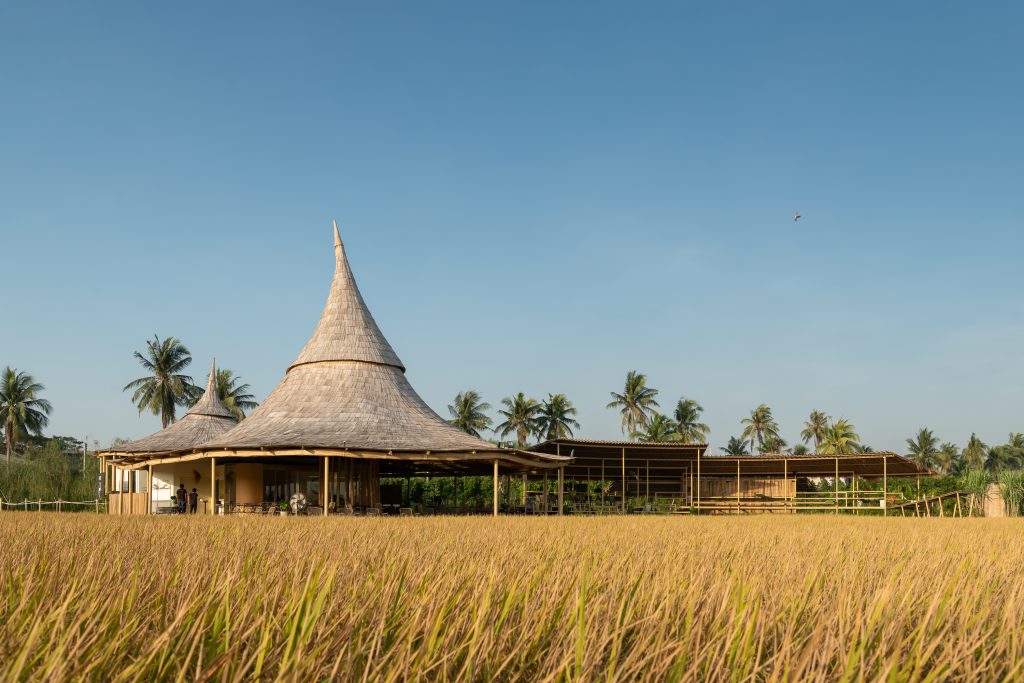
ผมคิดว่าอนาคตของวงการไม้ไผ่ในไทยกราฟจะขึ้นโดยไม่ลง คือมันเป็นเทรนด์โลกด้วย เป็นเทรนด์เรื่องการใช้วัสดุ แล้วเป็นสิ่งที่มันปลูกขึ้นในประเทศไทยเลย มันยั่งยืนสุดๆ สิ่งนี้ไม่ต้องนำเข้า เราต้องส่งออกด้วยซ้ำ ถ้าเราทำแบบแปลงไม้ไผ่ใหญ่ๆ ก็สามารถไปได้ถึงเศรษฐกิจชาติที่ขับเคลื่อนด้วยสิ่งนี้ได้ด้วย
“สุดท้ายก็นำมาสู่ปลายทาง คือเป็นสิ่งที่เราเป็นมาตอนต้น แล้วเราชอบมากที่สุด”
ในปีแรกของ ธ.ไก่ชน ให้ความสำคัญในส่วนของการผลิตและจำหน่ายไม้ไผ่ ตามมาด้วยเรื่องงานก่อสร้างรับเหมา แต่ในปัจจุบัน ธ.ไก่ชนลดสัดส่วนของงานรับเหมาลงจนงานเกือบทั้งหมดเป็นการประมูลให้ผู้รับเหมาจากบริษัทอื่น และให้ความสำคัญในสิ่งที่เป็นจุดเริ่มต้นของ ธ.ไก่ชน และเป็นสิ่งที่เขาชอบมากที่สุดนั่นคือ “งานออกแบบ” โดยเฉพาะการทำแบบเพื่อการก่อสร้าง แต่ทุกอย่างก็ยังอยู่ใน “ธ.ไก่ชน” ทั้งหมด ส่วนในอนาคต ธ.ไก่ชน กำลังมีแผนที่จะแบ่งส่วนการผลิตไม้และการออกแบบแยกจากกันอย่างชัดเจนเพื่อความคล่องตัวในการบริหารจัดการ
“สุดท้ายแล้ว ธ.ไก่ชน ก็ทำทุกเรื่องเพื่อให้รู้ ผลิตไม้เพื่อให้รู้จักไม้ ก่อสร้างเพื่อให้รู้รายละเอียด แต่สุดท้ายก็นำมาสู่ปลายทาง คือเป็นสิ่งที่เราเป็นมาตอนต้น แล้วเราชอบมากที่สุดก็คือการออกแบบ”ธ.ไก่ชน จึงเป็นบริษัทสถาปนิกที่มีความโดดเด่นจากการนำ “ไม้ไผ่” ซึ่งเป็นเหมือนสิ่งธรรมดาใกล้ตัวเราทุกคนมาเป็นส่วนหนึ่งของงานออกแบบ และทำให้หลายคนได้เห็นว่าสิ่งที่คิดว่าธรรมดานั้นมีความไม่ธรรมดาซ่อนอยู่ผ่านงานออกแบบ และ “ธ.ไก่ชนจึงเหมือนคำนิยามแทนตัวผู้ชายที่ชื่อ ตั๊บ ธนพัฒน์ บุญสนาน ได้ดีและชัดเจนที่สุด”
“Thor Kaichon was born from countless hours of non-stop working, not stopping for even one day.”
Thor Kaichon is an architecture firm known for its expertise in bamboo architecture. The name Thor Kaichon comes from the first letter of the studio founder’s name, Thanapat ‘Tup’ Boonsanan, (Thor stands for Thanapat ) while Kaichon is a Thai word for fighting cock, which Thanapat is personally passionate about. He takes inspiration from how Thai businesses in the past often used the first letter of the owner’s name followed by a simple word with straightforward imagery to catch people’s attention such as the elephant glue, the lion flour, the frog battery, or the monkey balm. We spoke to Thanapat about the origin of his studio, the management side of the business, and the visions he has for the future of bamboo architecture. And what an interesting conversation it was, especially revealing Thor Kaichon’s unique qualities as an architecture firm.
Thanapat or Tup graduated with a bachelor’s degree in architecture from the Faculty of Architecture, Silpakorn University. He spent the first two years of his profession working at an architecture firm in Bangkok before realizing that he didn’t like commuting and working in the city. Tup has always had a keen interest in natural materials and bamboo, and the body of knowledge surrounding the material became the subject he decided to dedicate his time pursuing. After a semester at King Mongkut’s Institute of Technology Ladkrabang, Tup packed his bag to join a bamboo architecture workshop facilitated by Dutch architect, Olav Bruin from 24H Architecture, in Chiang Mai. After the workshop was over, he decided to dive even deeper into bamboo and applied for an apprenticeship with Chiangmai Life Construction (CLC).
Through observation, conversations, and closely working with bamboo builders for three months, learning about the construction techniques, design, and bamboo treatments, he then started working on his first-ever bamboo architecture. The project is a reception building of Cool Downs Resort located in Mae Rim district of Chiang Mai. It is also the official foundation of Thor Kaichon and Tup has never worked on any architecture that doesn’t involve bamboo since. What got him and Thor Kaichon to where they are today was the restless hard work he put in during the company’s early days.
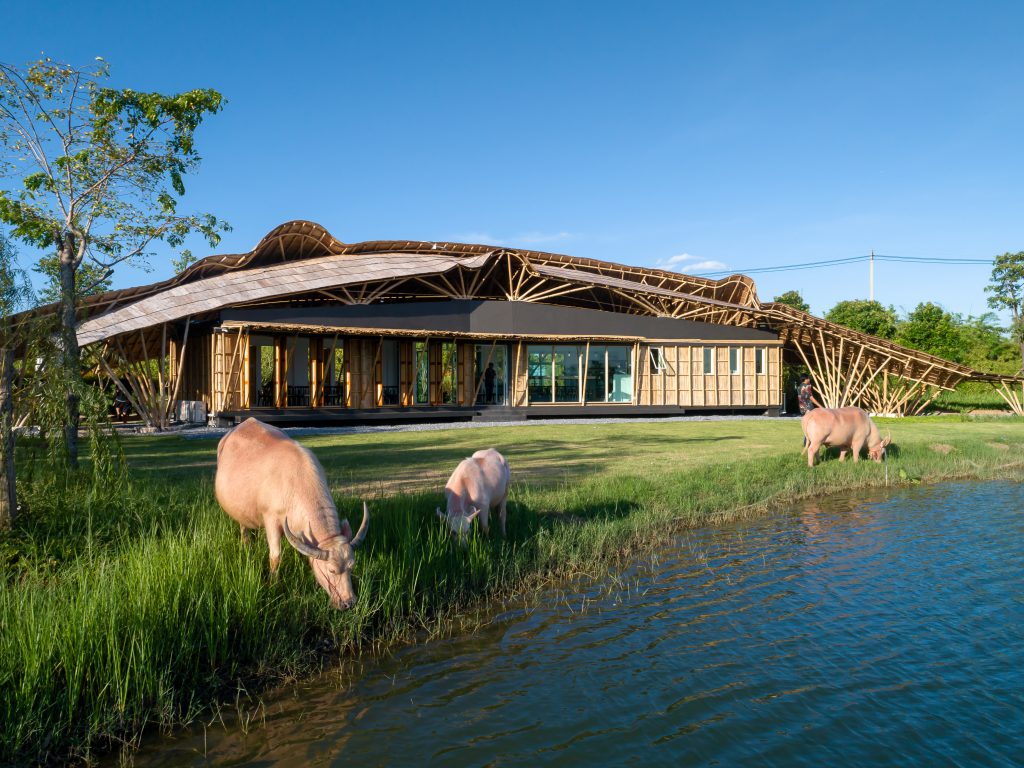
Running a contracting business with a factory in Bangkok while simultaneously working on the design and having to physically be in Chiang Mai sounds impossible. But I think I was able to pull through because I was working non-stop. I would take a day off when I felt like I needed it. Other than that, I would constantly be working. I was studying as much as I could about bamboo because my only goal at the time was to finish the project that I had already promised to do. I’ll do whatever it takes to complete it was my sole intention at the time.
“We are no longer the center of the world.”
In the first year, there was only one man who handled every position in the company, except the handicraft building part and bamboo treatments, and that man was Thanapat. Thor Kaichon is made up of three divisions 1) bamboo manufacturing and distribution, 2) contracting 3) architectural design. In the early days of its operation, the company focused primarily on the manufacturing aspects to build and operate its bamboo factory. Tub did everything by himself before he finally hired his first employee when the company went into its fourth year. Thor Kaichon is now entering its eighth year with eight employees. He also has a special position that assists in the construction of a particular site, where he continues taking the role of the chief executive and taking care of everyone. From solely managing the company to having 7 employees has changed his perspective. Thanapat understood that he was no longer the center of the world and the design was not completely dependant on him alone, but a collaboration.
“Lately, having worked with younger members of the team, I have been introduced to some new inputs and fresh ideas. I’m always glad to see unusual-looking designs, something that I would have never expected to see. I’m happy. And I don’t have to feel like I’m racking my brain all the time. I can think about other things now. It’s like I can finally breathe and let go of what I’d been gripping on so tightly all these times.”
Having more people in his team with new ideas and contributions, Tup can now spend more time designing and thinking about different aspects that can help him improve and create better works. With the staff helping not just the architecture but the administration and documentation part of the business, Tup has been more productive creatively. Being the only person handling all the administration and paperwork was without a doubt stressful, and it affected the quality of his designs.
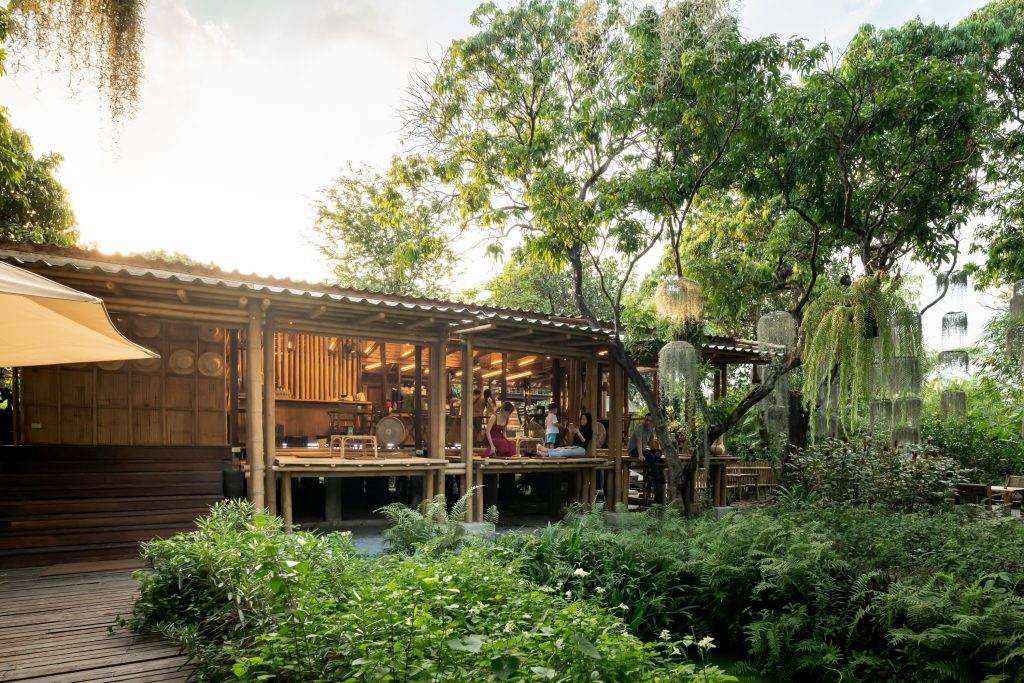
“If they like what we do, they are going to want to be a part of the team.”
The key to the way Tup runs Thor Kaichon is his attention to everyone’s well-being. From creating a good work environment, pleasant work atmosphere, and organizational culture to include a sense of belonging. Thor Kaichon has been adopting the work from home method since the very beginning. Tup doesn’t require his employees to come to the office to work. As the company moves into its eighth year, its main focus has geared more toward design.
Nevertheless, Tup decided to spend all his savings on the construction of the company’s office, believing that to inspire his staff to come up with high-quality works, they should also be surrounded by high-quality bamboo architecture. One of the features that stayed the same is the work-from-home method. Tub doesn’t force his staff to come to the office, but they prefer to go in anyway. To Tup, one of the first qualities that every staff member of Thor Kaichon has is the love, interest, and thirst to work.
“I choose people who admire what Thor Kaichon does. They have to like us first, like the way we work. If they like what we do, they are going to want to be a part of the team. I might end up choosing to hire a normal kid because he loves and is passionate about what we do. When you work here, it isn’t the mundane process of clocking in and clocking out, and then going to hang out with friends after work. Certain difficulties that come with the job, and if this isn’t something you like, if this nature of work isn’t your passion, it can be tough.”
“It was a process of trial and error from the beginning.”
“As the founder of the company and while setting up our firm, I’ve learned all the mistakes firsthand. Bamboo is a relatively new material, and that makes our work very experimental. It’s trial and error, from the business aspect to the manufacturing process, the construction, the design, everything. It’s a process of trial and error from the beginning. I may be accustomed to mistakes and failures, but I accept them, and I’ve never run away from them.”
There’s nothing perfect about the way Thor Kaichon works and evolves. Tub understands that when it comes to design and construction, mistakes are inevitable. But what he does every time he runs into problems is to fix them to the best of his abilities. He never looks for an easy escape. Working isn’t always smooth sailing and successful, and he always tells his team members that being in a construction business or choosing to be an architect doesn’t always give you a clear sky on the horizon because designing is about finding solutions.
“If you’re an architect and you feel discouraged by the problems coming your way, you can’t be one. Problems will always be a part of your job. If you ask me if I wanted to fix anything, I would rather fix what’s happening in the present. I don’t wish the fix the past. What’s done is done, but I know that when I face that issue again in the future, I’m going to solve it better than I previously had.”

While many view bamboo as a limitation in architecture, for Tup, the restrictions come from the collaborators be there engineers or contractors. Thor Kaichon works with an engineer who oversees the structural calculation of steel and concrete components that bear the weight of the bamboo structure. However, there haven’t been any engineers with specific expertise who specialize in bamboo structures, at least not in the way he’s creating with bamboo architecture. Working with an engineer is important to have them calculate the bamboo and weight-bearing structure. Builders and contractors are also what Tub finds to be a limitation in his work. In his view, if contractors with the right potential are more interested in bamboo architecture, they will be a significant contribution to the future of the field.
When asked about the future of bamboo architecture in Thailand, Tup says with confidence that he sees a promising sign for new growth and developments. And it isn’t just because of Thor Kaichon but because of a growing awareness of natural materials among governmental and private sectors. Even people in the architectural community, from architects and university professors to architecture students, have shown more recognition in the material. It is also a fact that bamboo is a sustainable material of today and the future.
“I think it’s going to be a continual rise from now on. Bamboo is now a global trend. It’s already a major trend in materiality, and it’s a plant that can grow well in Thailand. It’s highly sustainable in every aspect. We don’t have to import bamboo. We can export it even. If we can develop it into an actual industry with well-managed plantations, bamboo can be one of the resources that will help propel our economy.”
“It all leads up to this. This is who I am and it’s something I’ve always loved the most.”
The first year of Thor Kaichon was spent focusing on manufacturing and distributing bamboo. The contracting business was the next to follow. Nowadays, Thor Kaichon reduces the amount of contracting and uses almost entirely outsourced contractors through the bidding system.
The studio now concentrates on what started it all—the aspect that Tup loves the most about his work—‘design’. They design projects for actual construction, although every division is still operated under Thor Kaichon’s name. In the future, the company is planning to entirely separate the manufacturing department from the design division to enable more agile and effective management.
“At the end of the day, we do everything that helps us learn. We manufacture bamboo so that we can learn more about it. We build to learn about details and techniques. It all leads to this. It’s something I’ve always loved and still currently love the most, and that is design.”
Thor Kaichon is now known for its architectural expertise with its distinctive use of bamboo. They have proven over time that with design, there’s something extraordinary hidden in this seemingly ordinary material. “Thor Kaichon, in a way, is the best definition of who Thanapat ‘Tup’ Boonsanan really is.”


